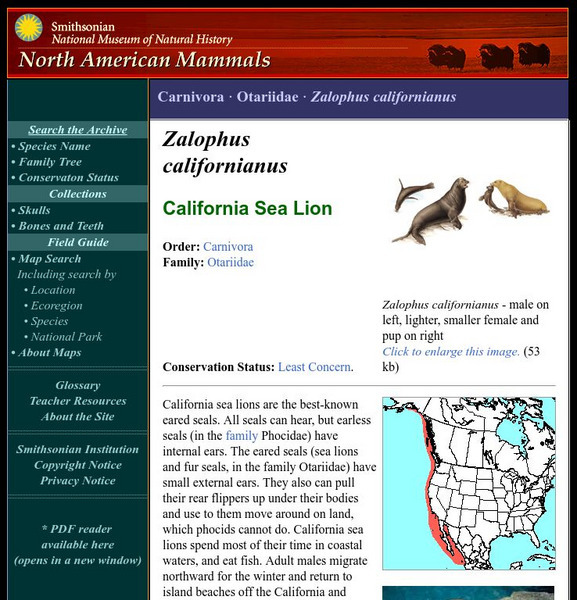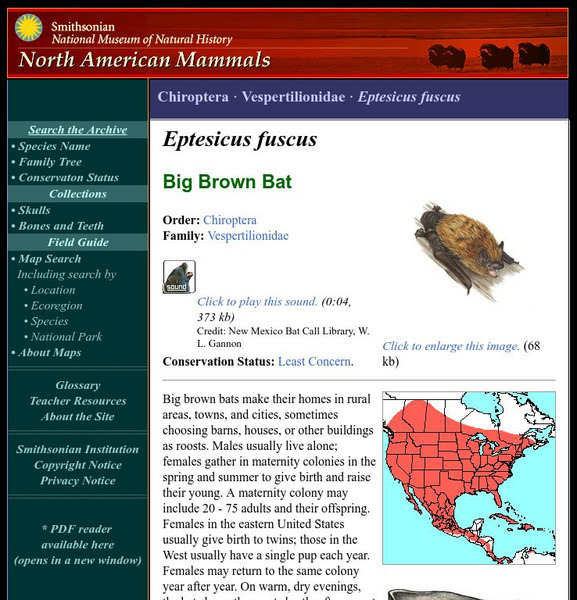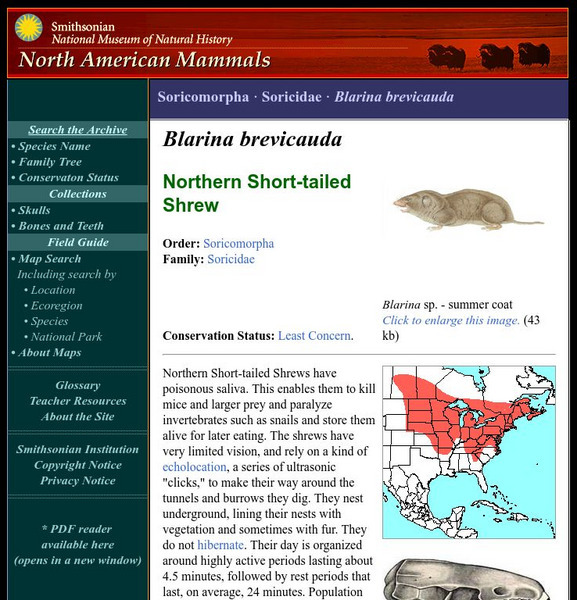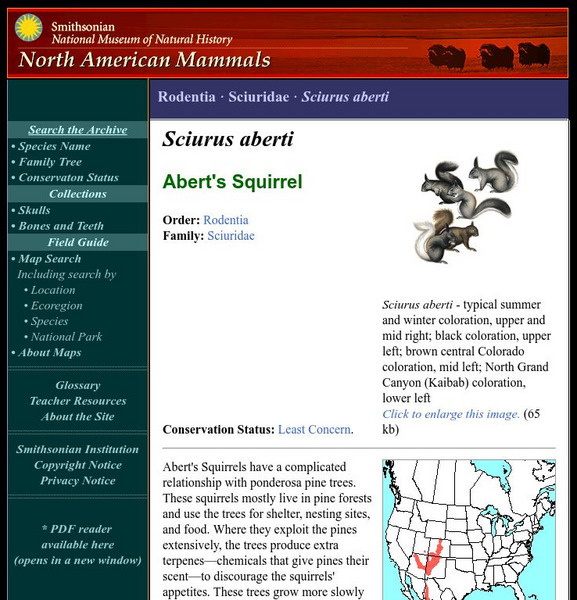Smithsonian Institution
National Museum of Natural History: American Mammals: Brown Bear, Grizzly Bear
Brown Bears are solitary, powerful predators who can be aggressive to one another. There is a social hierarchy: adult males are dominant, and females with cubs are dominant over juvenile males and females without cubs. Learn more about...
Smithsonian Institution
National Museum of Natural History: American Mammals: California Sea Lion
California sea lions are the best-known eared seals. All seals can hear, but earless seals (in the family Phocidae) have internal ears. Learn more about the Zalophus californianus, more commonly known as a California Sea Lion, in this...
Smithsonian Institution
National Museum of Natural History: American Mammals: Black Tailed Prairie Dog
Black-tailed prairie dogs exhibit the most complex social behavior of all prairie dogs. Social groups called "coteries" live together in very large colonies called "towns. Learn more about the Cynomys ludovicianus, more commonly known as...
Smithsonian Institution
National Museum of Natural History: American Mammals: Big Brown Bat
Big brown bats make their homes in rural areas, towns, and cities, sometimes choosing barns, houses, or other buildings as roosts. Males usually live alone; females gather in maternity colonies in the spring and summer to give birth and...
Smithsonian Institution
National Museum of Natural History: American Mammals: Bearded Seal
Bearded seals have relatively small heads and prominent whiskers. Males and females are similar in size and appearance. Learn more about the Erignathus barbatus, more commonly known as a Bearded Seal, in this easy-to-read species...
Smithsonian Institution
National Museum of Natural History: American Mammals: Baird's Pocket Gopher
Baird's Pocket Gopher is also known as the Louisiana Pocket Gopher, though most of what is known about its ecology has come from studies of the species near College Station, Texas, and it occurs in Oklahoma and Arkansas as well as in...
Smithsonian Institution
National Museum of Natural History: American Mammals: Atlantic White Sided Dolphin
Like other species of the genus Lagenorhynchus, the Atlantic white-sided dolphin is a stocky animal with a short, thick snout. It is common in cold North Atlantic waters. Learn more about the Lagenorhynchus acutus, more commonly known as...
Smithsonian Institution
National Museum of Natural History: American Mammals: Pacific White Sided Dolphin
Before the United Nations established a moratorium on the use of high seas drift nets in 1993, Pacific white-sided dolphins were frequently caught in the nets of Japanese and Korean squid fisheries. Today the species is better protected,...
Smithsonian Institution
National Museum of Natural History: American Mammals: Alaskan Hare
Female Alaskan Hares nurse their young for an extended period, providing them with enough nutrition to grow extraordinarily quickly during the short Alaskan summer. There is an average of six furry little hares in a litter, and females...
Smithsonian Institution
National Museum of Natural History: American Mammals: Northern Right Whale Dolphin
With no dorsal fin, a slender body shape that tapers steadily toward the tail, and small flippers and flukes, the northern right whale dolphin appears to be built for speed. It has been clocked at 34 km per hour and can dive as deep as...
Smithsonian Institution
National Museum of Natural History: American Mammals: Alaska Marmot
The Alaska Marmot lives in the Brooks Range, in northern Alaska, squeezing between big, bulky rocks on slopes to dig its dens. Denning on rocky ledges or under boulders offers them some protection from grizzly bears, which would...
Smithsonian Institution
National Museum of Natural History: American Mammals: Ginkgo Toothed Beaked Whale
Almost nothing is known of the ginkgo-toothed beaked whale. Nothing about its behavior or feeding habits has been reported, and its geographical distribution is estimated from a very small sample. Learn more about the Mesoplodon...
Smithsonian Institution
National Museum of Natural History: American Mammals: Western Small Footed Myotis
The western small-footed myotis occurs in limited areas of southwestern Canada, throughout much of the western United States, and into Mexico. It is better adapted to moist areas than to dry ones. Learn more about the Myotis ciliolabrum,...
Smithsonian Institution
National Museum of Natural History: American Mammals: Northern Short Tailed Shrew
Northern Short-tailed Shrews have poisonous saliva. This enables them to kill mice and larger prey and paralyze invertebrates such as snails and store them alive for later eating. Learn more about the Blarina brevicauda, more commonly...
Smithsonian Institution
National Museum of Natural History: American Mammals: Southern Short Tailed Shrew
The Southern Short-tailed Shrew is a highly active, primarily nocturnal predator. It is most common in moist, well-drained hardwood forests or pine stands, especially where deep organic litter provides easy burrowing for shelter and...
Smithsonian Institution
National Museum of Natural History: American Mammals: Abert's Squirrel
Abert's Squirrels have a complicated relationship with ponderosa pine trees. These squirrels mostly live in pine forests and use the trees for shelter, nesting sites, and food. Learn more about the Sciurus aberti, more commonly known as...















